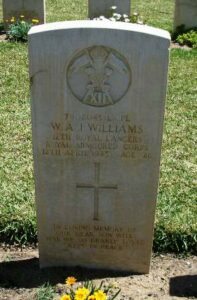Clyro is a village near the eastern border of Radnorshire, some 1.5 miles north-east of Hay-on-Wye. Clyro Court was built by Thomas Baskerville, a friend of Sir Arthur Conan Doyle, and supposed inspiration for his novel The Hound of the Baskervilles. The village is served by St Michael and All Angels Church, and the war memorial to the men of the village who fell during both World Wars is located within its Churchyard, in the form of a wooden crucifix on a stone base.
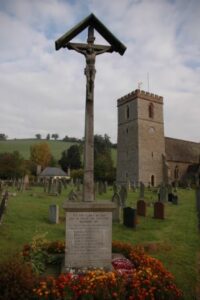
The Great War, 1914-1918
Francis Henry Anthony, Gunner, 121976, Royal Garrison Artillery. Francis was the son of Richard and Mary Anthony, of Clyro. He was a carpenter and married Catherine Elizabeth Roberts, of 46, The Mount, Shrewsbury, in 1916. Francis enlisted into the Royal Garrison Artillery and was posted to France with the 144th Siege Battery, Royal Garrison Artillery. The battery had been raised in Dover and embarked for France in August 1916. It would have taken part in the Somme offensive that year before moving to Ypres, and during the summer of 1917 took part in the Third Battle of Ypres. Francis was killed at Ypres on 12 September 1917, aged 34. He is buried in Bard Cottage Cemetery, Belgium.
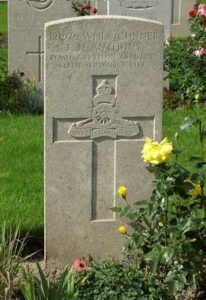
Ralph Hopton Baskerville, Captain, Glamorgan Yeomanry. Ralph was born at Clyro on 13 February 1883, the son of Walter Thomas Mynors Baskerville and Bertha Maria Baskerville, of Clyro Court. He had been commissioned into Cameron Highlanders on 13 August 1901 and saw service during the Boer War, transferring to the 1st Dragoons in March 1902. He was in America at the start of the war and returned from New York aboard the RMS Lusitania, which arrived in Liverpool on 20 October 1914. Ralph was commissioned into the Glamorgan Yeomanry upon his return and was granted the rank of Captain, before being attached to the 18th Battalion, Welsh Regiment. The battalion was attached to the 40th (Bantam) Division and moved to France during the first week of June 1916. Late in 1916 the division moved south to the Somme, and fought at the Battle of the Ancre, remaining in the area over the winter. In March 1917 the Germans withdrew to the Hindenburg Line, and the 40th Division was one of the Divisions that followed the withdrawal. Later in the year it took part in the Battle of Cambrai, playing an important role in the attack on Bourlon Wood. The division remained in the area over the coming months, but was caught here by the German Spring Offensive of 21 March 1918, and saw heavy fighting before being sent north to Flanders to rest and rebuild. However, on 9 April the Germans launched an offensive in Flanders, and the 40th Division were caught up in the thick of it again, being hit by gas and artillery shells, the 18th Welsh realised that the Portuguese in the front line were retreating in disarray, being closely followed by the Germans, advancing through the fog. The 18th Welsh formed a defensive flank to the south and began firing on the Germans who, soon afterwards, attacked the main line of the 18th Welsh. At around 6.30 am the Germans broke through between the 18th Welsh and 13th East Surreys and attacked the Welsh support line, which inflicted severe casualties upon them by accurate Lewis Gun fire. The battalion held out until around 8.00 am when the German barrage began falling behind them and the surrounded Welshmen were forced to fight for their lives. Within an hour the majority of the battalion had been wiped out. Ralph was 35 years old when he was killed during the terrible fighting on 9 April 1918. He has no known grave and is commemorated on the Ploegsteert Memorial, Belgium. A memorial plaque in his name was unveiled in St. John’s Church on 31 August 1919.
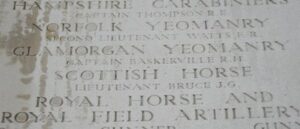
William James Fry, Private, 235860, Herefordshire Regiment. William was born in Winchcombe, Gloucester in 1896, the son of James and Sarah Fry. By 1911 the family was living at Tylyhylog, Clyro and William was working as a gamekeeper with his father. William enlisted at Hereford into the Herefordshire Regiment, and was posted to their 1/1st Battalion, which was attached to the 53rd (Welsh) Division. On 16 July 1915 he embarked at Devonport with the battalion, aboard the SS Euripedes, which set course for Port Said. On the morning of 9 August 1915, the battalion landed at ‘C’ beach at Suvla Bay, Gallipoli, taking part in heavy fighting over the coming days. The battalion remained on Gallipoli until being evacuated on 12 December 1915 and moved to Egypt with the division, joining the Egyptian Expeditionary Force (EEF). The division guarded the Suez Canal line for over a year, before taking part in the advance into Palestine, and saw heavy fighting during the First Battle of Gaza on 26 March 1917. The battle proved a disaster for the EEF, so on 17 April 1917 the EEF attacked again, during the Second Battle of Gaza. William was wounded during the unsuccessful attack, and died of his wounds on 20 April 1917, aged 20. He is buried in Gaza War Cemetery, Israel.
Albert Harris, Private, 26302, King’s Own Yorkshire Light Infantry. Albert was the son of George and Eliza Harris, of Clyro. He worked as a labourer prior to enlisting at Bridgend into the army and was posted to France, joining the 6th Battalion, King’s Own Yorkshire Light Infantry, which was attached to 43 Brigade, 14th (Light) Division. The Division was to see its first action during the Action of Hooge, where the Division was the first to be attacked by the German use of flamethrowers. It then fought at the Second attack on Bellewaarde. In July 1916 the Division moved to the Somme, and fought at the Battle of Delville Wood. The wood had been heavily fought over since 14 July by several divisions, including the South Africans, yet a month later was still partly in German hands. The 14th Division relieved the 17th Division on 12 August and 43 Brigade took part in a fresh attack against the north end of ZZ Trench, Beer Trench up to Ale Alley, Edge Trench and a sap along Prince’s Street. Albert was killed during this attack, on 16 August 1916, aged 22. He has no known grave and is commemorated on the Thiepval Memorial, France.
Frank Harris, Private, 31819, Royal Welsh Fusiliers. Frank was the son of Arthur and Annie Harris, of Weymouth Villa, Llandrindod Wells. He resided at Llanelli prior to the war, and enlisted at Llandrindod Wells on 29 June 1915 into the 3rd Battalion, Royal Welsh Fusiliers. Frank was posted to France on 30 September 1915, where he joined the 1st Battalion, Royal Welsh Fusiliers, which was attached to 22 Brigade, 7th Division. In the summer of 1916, the Division was on the Somme, and took part in the Battle of Albert, where it captured the village of Mametz, one of the few successes of 1 July 1916. Frank was killed that day, while acting a company runner. He was 18 years old, and is buried at Dantzig Alley British Cemetery, Mametz, France. His parents later named their house Dantzic Cottage. Frank is not commemorated on the Clyro war memorial, but at Llandrindod Wells and Llanelli.
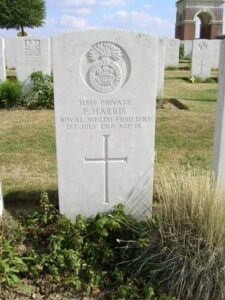
John Samuel Meredith, Private, 238902, King’s Shropshire Light Infantry. John was the son of Samuel Meredith, of Chapel Farm, Whitney-on-Wye. He worked on his father’s farm prior to enlisting at Glasbury into the Herefordshire Regiment. He was posted to France at some time after 1916, joining the 1st Battalion, King’s Shropshire Light Infantry, which was attached to 16 Brigade, 6th Division. The division took part in the Battle of Hill 70 in the spring of 1917, and then during the Battle of Cambrai later in the year. In the spring of 1918, the Division was one of those hit by the German Offensive on the Somme, which had been launched on 21 March, and took part in the Battle of St Quentin. It was moved from the line to Flanders to rest, but the following month the Germans launched another offensive on the Lys, and the Division saw more heavy fighting from 9 April onwards. During August 1918 the Allies had recovered sufficiently to be able to launch their own attacks on the Germans, and after a brilliant victory at Villers Brettoneux on 8 August, attacks were launched at Albert. The 6th Division, still in Flanders, was in the Dickebusch sector at the time, working in conjunction with the 106th American Infantry. On 13 August 1918 the 1st KSLI had just relieved the Americans when the Germans attacked one of their posts, capturing it before hurling a barrage of machine gun and artillery fire onto the front-line trenches. John was among a number of men killed during the attack. He was 25 years old and is buried in La Clytte Military Cemetery, Belgium.
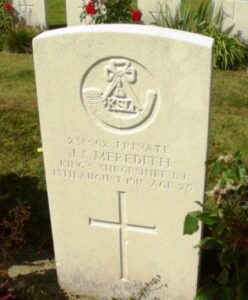
William Charles Morgan, Private, 2383, South Wales Borderers. William was born at Hay, the son of Thomas and Annie Morgan. His parents later lived at Bridge Lane, Wellington, Hereford. William enlisted at Abergavenny into the 1st Brecknock Battalion, South Wales Borderers. The battalion, under the command of Lord Glanusk, sailed from Southampton on 29 October 1914 with Home Counties Division and arrived at Bombay on 3 December 1914. The battalion then changed ship and sailed for Aden, arriving on 16 December 1914. William was only in Aden a month when the harsh conditions took their toll on his health, and he died of disease there on 25 January 1915, aged 24. William is buried in Maala Cemetery, Yemen.
Jasper Henry Mountford, Private, GS/74644, Royal Fusiliers. Jasper was the son of John and Margaret Mountford, of Old Forest, Clyro. He enlisted into the 106th Battalion, Training Reserve, before being posted to France early in 1918, joining the 7th Battalion, Royal Fusiliers, which was attached to 190 Brigade, 63rd (Royal Naval) Division. The division was in the Cambrai sector when the Germans launched their spring offensive of 21 March 1918 and took part in heavy fighting over the coming days and lost many men killed, wounded or missing. From 21 August 1918 the division took part in the great offensive. The 7th Royal Fusiliers, as part of 190 Brigade, were the follow up troops to the attack in the northern Somme sector that day and pushed forwards through the leading brigades towards Logeast Wood, but soon became detached from the rest of the division. Heavy fighting ensued throughout the day, but the line was held even though the battalion suffered heavy casualties. Jasper was among the men killed during that opening day of the great offensive on 21 August 1918. He was 19 years old and is buried in Achiet-Le-Grand Communal Cemetery Extension, France.
Thomas Thompson Pritchard, Second Lieutenant, Royal Flying Corps. Thomas was born at Knighton, Radnorshire in 1888, the son of Edward Jones Pritchard and Anne Pritchard (nee Evans). His mother was from Llanyre and Thomas had spent much of his youth with his aunt, Margaret Reynolds, at the Baskerville Arms, Clyro. Following the death of his father, the family moved to 30, Commercial Street, Gilfach Bargoed where Thomas worked as a baker. He enlisted into the Gloucestershire Hussars in January 1916 and became a despatch rider. He was commissioned as Second Lieutenant into the Royal Flying Corps in February 1917 and was posted to Yatesbury, in Wiltshire for pilot training. On 30 August 1917 Thomas was flying a B.E.2e, Serial B710 of 59 Training Squadron at Yatesbury when the aircraft stalled and spun out of control into the aerodrome, killing Thomas instantly. The remains of the 21-year-old were recovered from the wreckage and brought home for burial in St. Llyre’s Churchyard, Llanyre. Thomas is not commemorated on the Clyro war memorial.
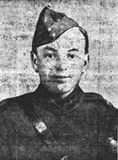
William Charles Roberts, Lance Corporal, 547713, Labour Corps. William was born in Marcham, Berkshire in 1885. By 1911 he was working as a coachman at Clyro Court and he married Margaret Ellen Trafford on 22 August 1911. Their daughter, Marjorie, was born the following year. William had served for several years with the 1st Volunteer Battalion, Royal Berkshire Regiment prior to moving to Clyro, and on 6 August 1914 re-enlisted into the regiment. He landed in France on 5 November 1914 and served there until returning to England on 2 September 1915. He was then transferred to the Labour Corps and was posted back to France on 6 May 1918, but his health was by now failing and less than six weeks later he returned to England after having been found wandering around in camp in a state of delirium. On 16 August 1918 he was discharged from the army as medically unfit, and he was sent to the Murthly War Hospital in Perthshire for treatment. He was discharged from Murthly before being transferred to the Brecon and Radnor Asylum, where he died of dementia and heart disease on 29 January 1919, aged 32. William is not currently commemorated by the CWGC, but he is buried in Clyro Churchyard. His case has recently been passed onto the CWGC.
Thomas George Warner, Private, M2/019693, Royal Army Service Corps. Thomas was born at Colchester in 1887, the son of Thomas Warner and Justine Elizabeth Warner (nee Scott). He moved to Clyro several years prior to the war, to work as a Chauffeur, and married Kate Ella Canfield, a Domestic Servant, there on 1 November 1908. Soon after the outbreak of war, Thomas enlisted into the Army Service Corps, and upon being drafted to France on 23 December 1914 was posted to the 2nd Division Motor Transport Company, as a Driver. Thomas served on the Western Front for the duration of the war and after the Armistice was posted to Cologne, as part of the Army of Occupation. He contracted broncho-pneumonia during the early weeks of 1919 and died at the 44th Casualty Clearing Station at Cologne on 14 February 1919, aged 32. Thomas is buried in Cologne Southern Cemetery, Germany. His son Cecil was killed whilst serving with the RAF in WW2.
World War Two, 1939-1945
Thomas Henry Anthony, Flying Officer, 124745, Royal Air Force Volunteer Reserve. Thomas was the son of Richard Albert and Elizabeth Jane Anthony, of Clyro. He enlisted into the Royal Air Force Volunteer Reserve early in 1940, and married Dorothy Freda Woodley, of Weston-Super-Mare, Somerset, in 1941. After his training as a Wireless Operator/ Air Gunner, he was posted to 57 Squadron, RAF, which had covered the BEF in France during the evacuation from Dunkirk, Boulogne and Calais and upon returning to England, moved to RAF Feltwell in November 1940 to re-equip with the Vickers Wellington. In September 1942 the squadron moved to RAF Scampton and converted to Avro Lancasters. On 21 January 1943, Thomas took off from Scampton aboard Lancaster W4267 on a cross country training flight. The aircraft encountered problems and crashed just north of Caistor, Lincolnshire, killing six of her crew. One man managed to bale out safely. Thomas was 28 years old when he died that day, and his remains were brought home for burial in St. Michael’s Churchyard, Clyro.
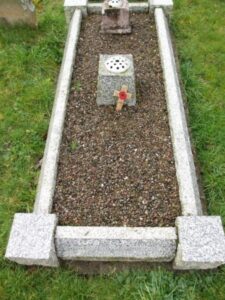
George Evans, Private, 1832833, Royal Electrical and Mechanical Engineers. George was the son of William Oliver Evans and Eliza Evans. He married Agnes May Stephens, of Pengenhill Common House, Llanigon in 1924. George enlisted into the Royal Electrical and Mechanical Engineers following the outbreak of war and probably embarked for North Africa. Following the fall of the Afrika Korps in 1943, the Allies launched attacks on the Italian mainland that year. George was killed in Italy on 24 August 1945, aged 41. Little else is known of him, as no unit is shown by the CWGC, but he was buried in Bari War Cemetery, Italy.
Raymond Griffiths, Private, 5392142, Hampshire Regiment. Raymond was born in Llandinam on 25 January 1906, the son of William and Anne Griffiths. By 1939 the family was living at Painscastle, where Raymond worked as a farm labourer. He married Elizabeth Jennie Williams, of Llanychaiarn, Cardiganshire in 1940 and the couple set up home at Clyro. He enlisted into the army and was posted to the 2nd Battalion, Hampshire Regiment. In November 1942, the Battalion sailed for North Africa, taking part in Operation Torch with the 1st Guards Brigade, disembarking at Algiers on 21 November to join the First Army. The battalion saw heavy fighting in December, being cut-off, but groups of men managed to get back to Medjez-el-Bab safely through German lines. Raymond survived this terrible fighting, but was killed in Tunisia on 22 February 1943, aged 37. He is buried in Enfidaville War Cemetery, Tunisia.
Cecil Warner, Pilot Officer, 126982, Royal Air Force. Cecil was born at Clyro on 23 May 1911, the son of Thomas George Warner and Kate Ella Warner. His father had served throughout the Great War, but died in Germany in 1919, so his mother moved the family from Clyro to South Kenton, Middlesex. Cecil enlisted into the Royal Air Force, and trained as an Air Gunner prior to being posted to 7 Squadron, Royal Air Force, which was a heavy bomber unit, based at RAF Oakington, in Cambridgeshire. On the evening of 25 August 1942, Cecil took off from Oakington aboard a Short Stirling I, Serial BF336, as part of a large bomber group despatched to destroy targets in Frankfurt. His Stirling was intercepted by a German night fighter on the outbound journey and was shot down near Charleville-Mezieres, with the loss of four of her crew. Three other men survived and were captured by the Germans. Cecil was 31 years old when he was killed that night and is buried with his fellow crewmen in Secheval Communal Cemetery, France. He is not commemorated on the Clyro War Memorial, although his father is.

William Arthur John Williams, Lance Corporal, 7908043, Royal Armoured Corps. William was the son of Mr and Mrs John Williams, of Clyro. He enlisted into the 12th (Prince of Wales) Royal Lancers, which was an armoured car unit at the start of the war, and covered the retreat of the BEF to Dunkirk. After evacuation, without their vehicles, from Malo-les-Bains on dredgers, they were first equipped with Beaverettes, then, in June 1941, with Humbers. The Lancers landed in Port Tewfik, Egypt, in November 1941 and fought as divisional troops for the 1st Armoured Division at the Second Battle of El Alamein in October 1942. William was killed in Tunisia on 12 April 1943, during the operation to recapture Tunis. He was 26 years old and is buried in Enfidaville War Cemetery, Tunisia.
